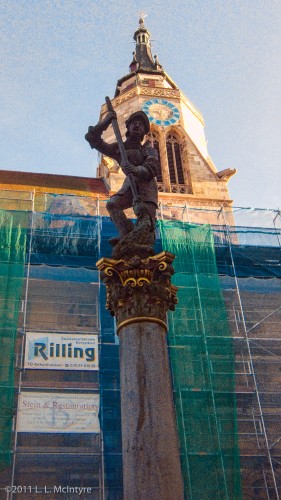Today on Monday Mysteries we answer the question: why does the statue of St. George in Tübingen sometimes seem to be standing on a purple column?
An old fountain with a figure of St. George slaying a dragon stands in the Holtzmarkt, the plaza in front of the big Collegiate Church of St. George (Stiftskirche) in Tübingen. People restoring the statue in the late 1970s/early 1980s discovered evidence that the statue was painted colors, and so a controversial decision was made paint the statue during the restoration, using bright colors that would have been used in the middle ages. People argued for and against that for a while, but the mayor wanted it painted. So in the end, since he got to make the final decision, the statue was painted.
So it’s painted. A few days before the big unveiling of the newly painted statue, there’s a big cloth draped over the top of it. The mayor peeks underneath the covering. To his surprise — and great displeasure — he discovers that a vandal (or vandals) had painted the supporting column purple. A very, very bright purple.
The mayor was not amused.
He immediately offered a 3000 Deutchmarks reward (~$2000 USD in today’s currency) for information leading to the arrest of the vandal(s). Eventually, 2 teenagers came forward and said that a 3rd teen had done it. The major suspected that all 3 of the teenagers had really done it together, but that could never be proven, so the ones who came forward actually did collect the reward in the end, while the 3rd one served time in jail.
In the meantime, the problem remained of what to do about the column. It was supposed to be a natural stone color, as opposed to being bright purple. There’s no information in the book as to whether or not they attempted to just remove the paint in any way, which would have seemed to me to be the first thing to try. But, according to the book, what they decided to do was to paint a “natural stone-like” color on top of the purple paint.
While that worked OK in the short-term, it has turned out to be an unfortunately bad decision in the long-run. Periodically that paint comes off, revealing the purple underneath, which means the column needs to be repainted a “natural” color fairly often.
Here’s a photo of the column that I took back in 2011, when the church behind the fountain was covered in colorful scaffolding:
And here’s a photo I took last month of the column, when there’s no scrim on the church:
I you look closely at the first photo, you can, with some effort, perceive a slight lilac color. However, is it real, or is it just some color artifact bleeding over in the photo onto the column, with the colors coming on the scrim behind? I’m not sure.
You see, I don’t see any purple at all in the second, more recent photo. I dragged Chris over there recently specifically to help me find the purple part, and neither one of us could find it in person.
But, the book insists that it’s there. So, maybe the first photo above, the one from 2011, really is showing a slightly purple column. The fact that my more recent photo — and our view of the column in person — doesn’t show any trace of the purple could indicate that they’ve recently repainted the column.
Perhaps. It’s plausible, I suppose.
Of course, perhaps if you saw the chicken on the church, you’ll also have no trouble seeing the purple here… 😉


